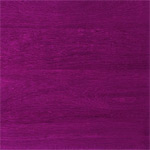Serving Upstate NY—VT—MA • For selections & prices, CALL or EMAIL US
Purpleheart (Pau Roxo)
Grades & Properties of Wood Flooring —
Exotic Species
Scientific Name:
Peltogyne spp.
Other Common Names and Related Species:
- Amaranth
- Amarante
- Barabau
- Bois Violet
- Guarabu
- Koroboreli
- Morado
- Nazareno
- Palo Morado
- Pau Roxo
- Purperhart
- Tananeo
- Violetwood
Shop online now for Purpleheart Flooring »
Origin:
Central and Latin America and Southeast Asia.
Janka Hardness: 1860
Purpleheart (or Pau Roxo) has about the same hardness as Tigerwood.
Grades of Purpleheart Flooring:
Clear grade Purpleheart flooring is color-sorted for a rich purple color. Clear grade is typically the only desirable grade.
Purpleheart Flooring Dimension Specifications:
Very little pre-milled Purpleheart flooring is imported from South America because of its low demand for an entire floor. Periodically pre-milled Purpleheart flooring is available. Lengths of the pre-milled Purpleheart flooring bundles are 7 feet so they can easily fit into 8-foot-wide steel shipping containers. All pre-milled products are tongue-&-groove and end-matched (tongue-&-grooved on the ends of the boards). Moisture content ranges from 6% to 8% for quick acclimation. The average length of the flooring pieces is usually about 3 feet and ranges from 1 to 7 feet. Almost all imported flooring that is found is in 7-foot bundles, with widths available from 2¼″ to 5″. Typically, if a long or wide plank floor is desired, raw lumber must be obtained and the flooring must be milled here in the United States. Typically, the lengths can develop up to 12 feet. However, the cost can be double that of the pre-milled stock because of waste and labor costs in the United States. Also, raw lumber is relatively expensive because it is taxed more heavily than finished products to support local economies in South America. Purpleheart flooring is normally made to order in this fashion.
Flooring Availability:
Purpleheart flooring is usually only available in unfinished solid, but prefinished solid or engineered is available by extreme special order. Purpleheart is uncommon in comparison with many Brazilian species such as Brazilian Cherry. There is a large amount of Purpleheart in South America, and it is not endangered. However, less logging, stricter regulations, and a slower American economy have slightly limited commodities and caused slightly higher prices of this product in this country.
Finished Floor Appearance:
A Clear grade will have a very purple appearance. Pupleheart’s color will darken drastically to a brown. Oil-based finishes allow Purpleheart to darken and is not recommended. Water-based finishes will preserve the natural color longer.
Flooring Durability and Stability:
Purpleheart flooring is extremely durable and resists denting and traffic wear quite well. It is harder than many North American species because of its density and is relatively stable. Purpleheart flooring is heavy, weighing about 3 pounds per square foot.
Workability of Purpleheart Flooring:
Extremely hard and tough, Purpleheart works with some difficulty with both hand and power tools. When installing Purpleheart flooring, it is best to use a manual nailer, but staples and pneumatic nailers can be used with care. It holds screws well, and it glues, stains, and polishes to a very attractive finish. It can be somewhat difficult to sand with flooring equipment because of its hardness. Professional sanding and finishing is recommended. This wood is very resistant to decay and insects; these resistant properties may contribute to a possible allergic response to the dust. To avoid a possible allergic reaction to the material, wear a dust mask and long-sleeve shirt when working with Purpleheart.
Principal Uses of Purpleheart Flooring:
Purpleheart flooring is used mostly in borders and medallions and in medium- and high-end residential and commercial applications for a dramatically elegant accent. It works well in contemporary structures as well.





